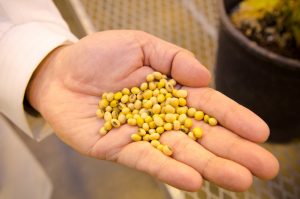When the Human Genome Project began in 1990, the goal was to sequence and map all of the genes that make up the human DNA. That project was completed in 2003 – and genome projects on many other species followed in subsequent years.
Several crops grown in Missouri soon underwent genetic sequencing and mapping, including soybeans. The first soybean cultivar to be sequenced, “Williams 82,” was published in 2010. This widely-grown cultivar was chosen to represent the northern United States germplasm. For nearly a decade, this cultivar has served as the main soybean reference genome – the sequence that gives scientists a baseline of a species’ set of genes.

A few years later, Henry Nguyen, Curators’ Distinguished Professor of Plant Sciences in the University of Missouri College of Agriculture, Food and Natural Resources, wanted to develop additional reference genomes, this time focusing on soybeans grown in the southern U.S., as well as a wild ancestor of soybean. These two reference genomes, soybean cultivar “Lee” and wild type PI 483463, are now available at GenBank (under accessions PELE00000000 and PGFP00000000) and SoyBase.
Nguyen, who led the research effort, worked with a group of scientists from MU, the United States Department of Agriculture-Agricultural Research Service (USDA-ARS), the HudsonAlpha Institute for Biotechnology, Pacific Biosciences, Bionano Genomics and Washington University, in addition to international collaboration with the University of Western Australia and the Chinese University of Hong Kong.
“The significance here is that we now have three reference genomes for soybeans,” Nguyen said. “Having those reference genomes gives us a solid foundation to build on and allows us to continue to understand the genetic diversity of soybeans. If we want to increase yields, improve disease resistance and seed composition quality, and allow for better stress adaptation and resilience, we have to understand how the genetics work.”
Having a map of soybean genes is key for breeders, who work to develop varieties that farmers can use to help battle diseases and other environmental factors. The soybean is an extremely important crop on a worldwide level as well. Approximately 340 million metric tons of soybeans are produced globally each year, with the market for soybeans worth $40 billion each year in the U.S. alone.
Soybeans are extremely common in the Midwest. The crop is grown as far north as Minnesota and North Dakota and as far south as Georgia and Florida.
“Soybean cultivars differ by their genetic background and environmental adaptation,” Nguyen said. “Williams 82 is considered a northern germplasm. I thought that it was important to have a southern germplasm as well.
“Genetically, it makes sense to select another diverse cultivar. We feel like with these two varieties, we have a good representation of U.S. soybean germplasms that we utilize in the breeding and genetics world. Moreover, genome sequence of a wild soybean will help identify untapped genetic diversity.”
Having several reference genomes will allow breeders to develop and deliver new varieties more quickly and efficiently. The purpose of this sequencing project, “Better Soybean, Better Life,” is to assist molecular breeding and genome editing in order to enhance the productivity, biotic and abiotic stress tolerance, and nutritional quality of soybeans around the world.

“The United Soybean Board (USB) is pleased to note the release of two key reference genomes for soybean,” USB said in a statement. “This represents fruition of a collaborative effort led by the University of Missouri, as partially funded by the United Soybean Board.”
Soybeans originated in Asia, with China serving as a center of diversity and domestication. Wild soybeans (Glycine soja) were most common in those times. Soybeans were later domesticated and cultivated (Glycine max). While the soybean was introduced to the United States more than 250 years ago, a complete realization of its value really took shape after World War II.
The soybean can used in a variety of ways, from cooking oil to animal feed. The seed has a high oil content and plays a big role in biofuels and biodiesels.
“The new genome assemblies will be important for several reasons,” said Steven Cannon, research geneticist (plants) with USDA-ARS. “The Lee cultivar is an important variety in the southern U.S., and has been used as a parent of many other commercial soybean lines. The other new genome sequence is from a close wild relative of soybean, and will give a picture of how soybean was domesticated, starting several thousand years ago in Asia. These high-quality assemblies are also being used to improve the first soybean to have been sequenced, for the northern cultivar Williams 82. Together, these genome assemblies should help researchers more rapidly identify important genes, and to efficiently produce improved soybean varieties.”
Funding for the sequencing project was provided by the United Soybean Board and three private companies: Bayer CropScience, DOW AgroSciences and Monsanto. Investigators on the project include: Henry Nguyen and Babu Valliyodan (University of Missouri); Gunvant Patil (University of Minnesota); Steven Cannon and Qijian Song (USDA-ARS); Wes Warren (Washington University); Hon-Ming Lam and Ting-Fung Chan (Chinese University of Hong Kong); Dave Edwards (University of Western Australia); and Jeremey Schmutz (HudsonAlpha Institute for Biotechnology).
“We are proud of the research done by Dr. Nguyen and his team in the MU College of Agriculture, Food and Natural Resources,” said Christopher Daubert, vice chancellor and dean of CAFNR. “These reference genomes will play a significant role in helping soybean breeders develop soybean lines that are better able to fight disease and environmental stresses. This project is a terrific example of collaboration and partnership for Missouri agriculture and its soybean industries.”